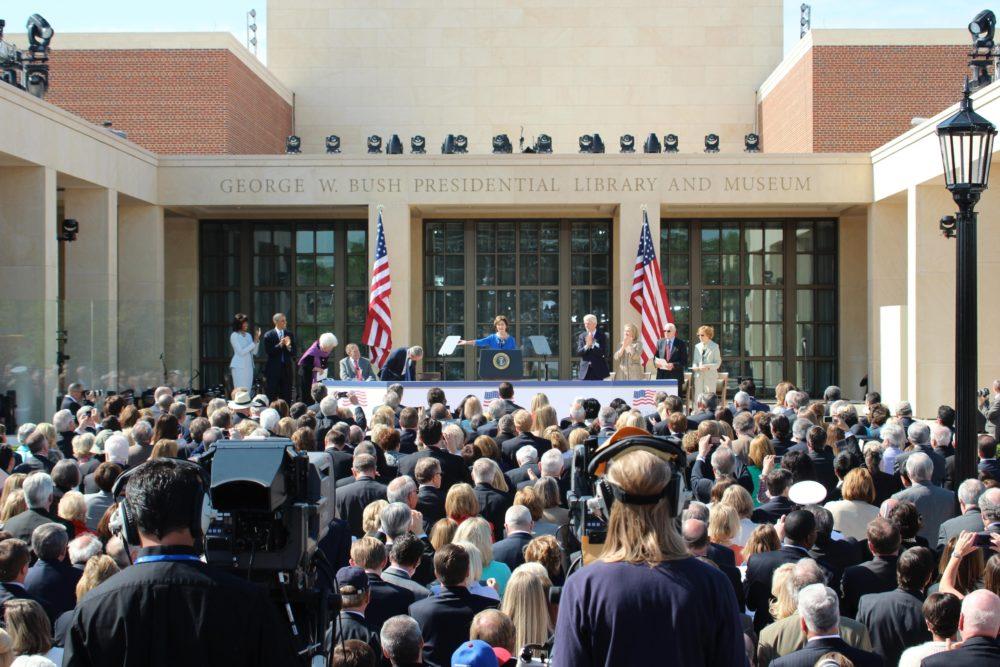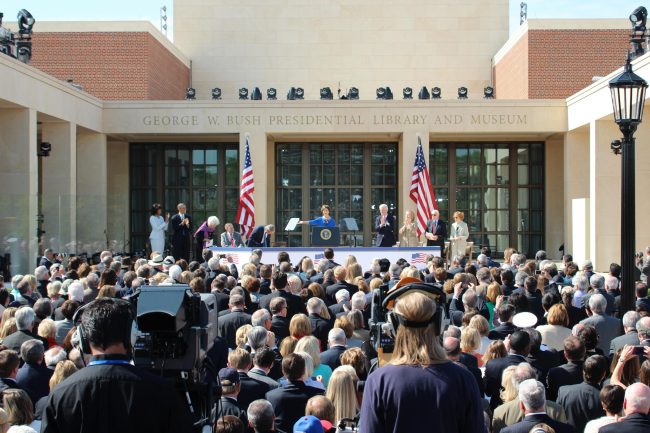
The George W. Bush Presidential Library and Museum was dedicated to much fanfare. More than 10,000 guests were in attendance. (Christopher Saul / The Daily Campus)
Honestly, I was not as thrilled as my peers on the SMU campus to welcome the Bush Center and the Bush family. I have been raised in a fairly open-minded household and was aware of events that were happening in our country at a very young age. I felt the Bush Center would taint the reputation of the university because of the difficult decisions that were made during the “Bush Era” including the “weapons of mass destruction” issue, the decision to not double down during the Iraq War and whether the decision to go to war was wrong.
As a person who is concerned with the well-being of others of every race, ethnicity, religion, sexual orientation or what country they come from, my outlook on the Bush Center was focused on the negative moral aspect, not the other positive things it has and will bring to the university.
I attended the political forum on Wednesday afternoon with David Gregory and various other former White House staff members.What I received was far more than I bargained for.
I’ve been watching “Meet the Press” with David Gregory ever since I knew what the president actually did (which was around 1st grade). I feel he does an excellent job of covering what needs to be covered without adding much opinion. Gregory has had a front row seat to major events in history, and now we, as students, have the same opportunity.
Gregory started out the forum by welcoming the panel and asking why they thought the Bush Center was important to open.
Dan Bartlett, former counselor to President George W. Bush, said it was neat to see it all come together. “[Seeing everyone] it was like a family reunion. The museum was truly built in the post-digital era. The university will be a beacon for the world.
Andrew Card was joined by his predecessor Josh Bolten. Both served as White House Chief of Staff to U.S. President George W. Bush. Card said the museum goes through the process that G. W. Bush went through while making his decisions. Visitors will get to go back to what it was like to face the challenges he went through. “It is a very optimistic museum.”
Bolten made it a point to say the Bush Center was ” [the staff’s] time to set the record straight.”
At this point in the forum, I had really started thinking: The American people tend to forget that the presidents are normal people that are chosen and elected by us to run our country. They function the same way we do, celebrate the same way, and regret decisions like all of us. We the people don’t notice it until the president is out of office. We are so quick to judge the president on their decisions because they are running our country, but what we fail to understand is that they have multiple things going on at once while trying to maintain their sanity. We focus on the negative, not the positive.
I think that Anita McBride, who served as assistant to President George W. Bush and Chief of Staff to First Lady Laura Bush, said it best when she described that during the Bush presidency the press was focused on the war because that was the main focus.” It was hard for the [Bush’s] staff to get the good stories through.” No one really knew about the Malaria Initiatives that the first lady and the president worked to establish in Africa that saved many lives. Not many knew about the five trips First Lady Laura Bush made to Afghanistan to learn and help the Afghan women. The people of America only saw the negative because the press “reflected the mood of the country,” Gregory said.
Gregory answered an audience question about how the press handled the Bush era. He said that the press didn’t dig as deep as they should or could have because there was a lot of “fear and pain in the country [after 9/11]…. The government needed room to do what they had to do.”
Gregory ended with one final word of advice to the journalism students attending: “Take advantage of this library and wrestle with these issues. You have this opportunity as journalists.”
The Bush Center brings great recognition and high rankings to SMU. People will come from all over the world to study the documents and examine the decisions that were made during the Bush Administration. The $250 million center was constructed by donor’s money, not tax payer’s dollars, according to the center’s website. Undergraduates and graduate students from all across the world will have opportunities to pair with the center for research on women’s issues, military initiatives, education reform and so much more. SMU is now the center of the spotlight. But protestors do not want a library in Dallas that represents an administration who “committed war crimes and crimes against humanity and must be held to account,” Hadi Jawad, an activist with the Dallas Peace Center, said.
I think it is an amazing and historical time for the university and I am honored to be here during this period. After struggling with myself but keeping an open mind at these events, I welcome the Bush family and Bush Center to SMU.
Although the Bush Center brings worldwide recognition to SMU, a place to conduct in-depth research, and where the administration can be examined, is it worth giving up our morals and what supporting this museum means?
Esaili is a sophomore majoring in journalism.









